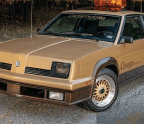
What’s a gow job? Quite simply, “gow job” is a handy term for differentiating the kinds of homebuilt performance cars constructed before World War II from those that came after. The phrase itself is old-time California-speak. Its origins, and even pronunciation, are hotly debated—those who were there, like centenarian camshaft grinder Ed “Isky” Iskenderian, pronounce “gow” to rhyme with “cow.” We suspect the true etymology is simply the word “go” spoken by the Southern-accented immigrants from dust-bowl Arkansas and Oklahoma who were flowing into California in the ’20s and ’30s. Blame Hot Rod magazine for the term falling out of favor: that periodical’s 1948 debut got the rest of the country calling any car modified for speed or acceleration a hot rod instead.
Still, the nomenclature change is useful. Gows evolved out of existence after the war, but as our cover car demonstrates, their revival has been under way since the 1970s and has only picked up steam since. The new participants were all born after the hot rod took over—many were born after the ’70s—suggesting there’s a lot more at play here than mere nostalgia. Style, simplicity, and fun are the big reasons people are putting these cars together—the time-travel aspect is there, but one gets the sense that the big appeal is the same as it was when they were done the first time. They’re great looking cars that are easy to build and a blast to drive.
If the gow job is defined at the near end of its existence by its evolution into the hot rod, it must similarly be compared with the speedster at the time of its origins. A huge aftermarket grew up in the 1920s catering to Ford Model T owners (with add-on mechanical braking systems to supplement Ford’s transmission brake being perhaps the single most sought-after accessory) and the extremely affordable, even disposable, nature of used Fords made them the perfect basis for a homebuilt motorized machine of any type. Making a Model T go faster was mostly a matter of discarding the body and fenders, rigging up some seats and a fuel tank, and going for a spin. Lowering, custom bodywork, and other refinements soon followed.
It wasn’t long before aftermarket pieces and the speedster ethos found their way into stock-bodied cars. Some outfits, like Los




